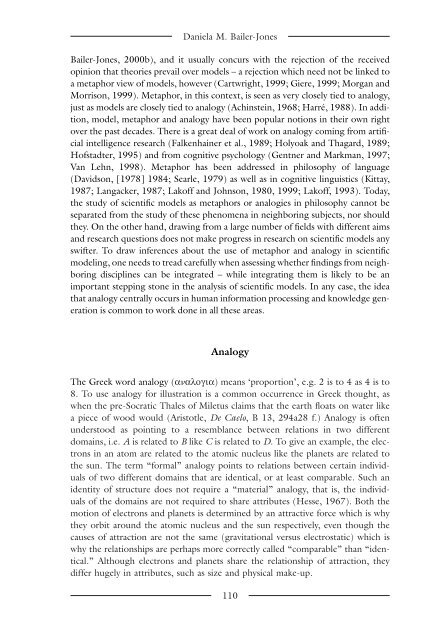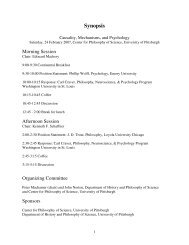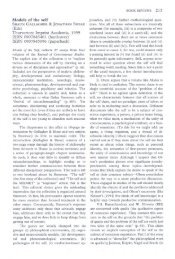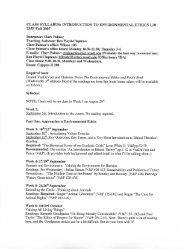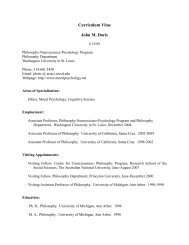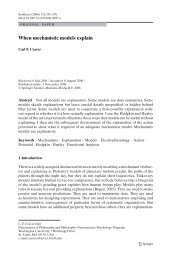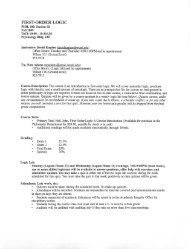The Blackwell Guide to the Philosophy of Science - The Department ...
The Blackwell Guide to the Philosophy of Science - The Department ...
The Blackwell Guide to the Philosophy of Science - The Department ...
You also want an ePaper? Increase the reach of your titles
YUMPU automatically turns print PDFs into web optimized ePapers that Google loves.
Daniela M. Bailer-Jones<br />
Bailer-Jones, 2000b), and it usually concurs with <strong>the</strong> rejection <strong>of</strong> <strong>the</strong> received<br />
opinion that <strong>the</strong>ories prevail over models – a rejection which need not be linked <strong>to</strong><br />
a metaphor view <strong>of</strong> models, however (Cartwright, 1999; Giere, 1999; Morgan and<br />
Morrison, 1999). Metaphor, in this context, is seen as very closely tied <strong>to</strong> analogy,<br />
just as models are closely tied <strong>to</strong> analogy (Achinstein, 1968; Harré, 1988). In addition,<br />
model, metaphor and analogy have been popular notions in <strong>the</strong>ir own right<br />
over <strong>the</strong> past decades. <strong>The</strong>re is a great deal <strong>of</strong> work on analogy coming from artificial<br />
intelligence research (Falkenhainer et al., 1989; Holyoak and Thagard, 1989;<br />
H<strong>of</strong>stadter, 1995) and from cognitive psychology (Gentner and Markman, 1997;<br />
Van Lehn, 1998). Metaphor has been addressed in philosophy <strong>of</strong> language<br />
(Davidson, [1978] 1984; Searle, 1979) as well as in cognitive linguistics (Kittay,<br />
1987; Langacker, 1987; Lak<strong>of</strong>f and Johnson, 1980, 1999; Lak<strong>of</strong>f, 1993). Today,<br />
<strong>the</strong> study <strong>of</strong> scientific models as metaphors or analogies in philosophy cannot be<br />
separated from <strong>the</strong> study <strong>of</strong> <strong>the</strong>se phenomena in neighboring subjects, nor should<br />
<strong>the</strong>y. On <strong>the</strong> o<strong>the</strong>r hand, drawing from a large number <strong>of</strong> fields with different aims<br />
and research questions does not make progress in research on scientific models any<br />
swifter. To draw inferences about <strong>the</strong> use <strong>of</strong> metaphor and analogy in scientific<br />
modeling, one needs <strong>to</strong> tread carefully when assessing whe<strong>the</strong>r findings from neighboring<br />
disciplines can be integrated – while integrating <strong>the</strong>m is likely <strong>to</strong> be an<br />
important stepping s<strong>to</strong>ne in <strong>the</strong> analysis <strong>of</strong> scientific models. In any case, <strong>the</strong> idea<br />
that analogy centrally occurs in human information processing and knowledge generation<br />
is common <strong>to</strong> work done in all <strong>the</strong>se areas.<br />
Analogy<br />
<strong>The</strong> Greek word analogy (aalogia) means ‘proportion’, e.g. 2 is <strong>to</strong> 4 as 4 is <strong>to</strong><br />
8. To use analogy for illustration is a common occurrence in Greek thought, as<br />
when <strong>the</strong> pre-Socratic Thales <strong>of</strong> Miletus claims that <strong>the</strong> earth floats on water like<br />
a piece <strong>of</strong> wood would (Aris<strong>to</strong>tle, De Caelo, B 13, 294a28 f.) Analogy is <strong>of</strong>ten<br />
unders<strong>to</strong>od as pointing <strong>to</strong> a resemblance between relations in two different<br />
domains, i.e. A is related <strong>to</strong> B like C is related <strong>to</strong> D. To give an example, <strong>the</strong> electrons<br />
in an a<strong>to</strong>m are related <strong>to</strong> <strong>the</strong> a<strong>to</strong>mic nucleus like <strong>the</strong> planets are related <strong>to</strong><br />
<strong>the</strong> sun. <strong>The</strong> term “formal” analogy points <strong>to</strong> relations between certain individuals<br />
<strong>of</strong> two different domains that are identical, or at least comparable. Such an<br />
identity <strong>of</strong> structure does not require a “material” analogy, that is, <strong>the</strong> individuals<br />
<strong>of</strong> <strong>the</strong> domains are not required <strong>to</strong> share attributes (Hesse, 1967). Both <strong>the</strong><br />
motion <strong>of</strong> electrons and planets is determined by an attractive force which is why<br />
<strong>the</strong>y orbit around <strong>the</strong> a<strong>to</strong>mic nucleus and <strong>the</strong> sun respectively, even though <strong>the</strong><br />
causes <strong>of</strong> attraction are not <strong>the</strong> same (gravitational versus electrostatic) which is<br />
why <strong>the</strong> relationships are perhaps more correctly called “comparable” than “identical.”<br />
Although electrons and planets share <strong>the</strong> relationship <strong>of</strong> attraction, <strong>the</strong>y<br />
differ hugely in attributes, such as size and physical make-up.<br />
110


